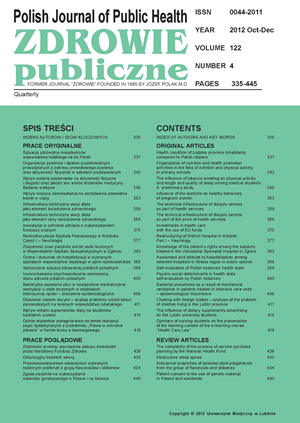Opinions of nursing students on the presentation of the learning content of the e-learning course “Health Care Law”
DOI:
https://doi.org/10.12923/j.0044-2011/122-4/a.16Keywords:
blended-learning, distance learning, quality of teaching, health care lawAbstract
Introduction. For the first time in the history of the Faculty of Health Science, Warsaw Medical University, the e-learning course in “Education in Health Care Law” was started in the academic year 2011/2012.
Aim. The aim of the study was to analyse the opinions of students on the presentation of the learning course in the form of an e-learning course.
Material and methods. A group of 156 Master’s degree students (39%) participated in the study: 84 second year full-time students and 72 first year part-time students, including 152 women. An anonymous questionnaire on Moodle e-learning platform was used as a research method: https://docs.google.com/spreadsheet/viewform?formkey=dGpoU0puUk5Qak9xaUpnOEN2NTZNX3c6MQ.
Results. Ninety eight percent (98%) of the students participated in an e-learning course for the first time and would be interested in this form of learning in the future (78%). Seventy percent (70%) of the study participants reported that the course improved the quality of teaching. Ninety one percent (91%) of the students admitted that the learning content was interesting, and 70% of the study participants reported that this form of teaching made them interested in the course and motivated them to broaden their knowledge. Among the most interesting modules were those concerning: patients’ rights and nursing organizations. During the e-learning course, 61% of the study participants devoted more time to learning compared to traditional courses. As little as 20 persons experienced technical difficulties when using Moodle platform.
Conclusions. Positive opinions on the e-learning course and its positive influence on the quality of teaching of this subject prevailed among the study group of students. Studies on opinions of students will be continued among a larger group of students, because the remarks of the students allow organizational improvement of the courses in compliance with their expectations, which may further improve the quality and attractiveness of online learning as well as its effectiveness.
References
1. Dokumenty Rady Głównej Szkolnictwa Wyższego. Standardy kształcenia dla kierunku studiów Pielęgniarstwo. Dostępny pod adresem: http://www.rgsw.edu.pl/files/active/0/pielegniarstwo20070210.pdf [19.01.2012 r.]
2. Michowska M. E-learning i jego wykorzystanie w nauczaniu etyki. In: Nauczanie etyki w uczelniach medycznych – Gdańsk; 2007. p.169-73.
3. Radon K, Kolb S, Reichert J, et al. Case-based e-learning in occupa¬tional medicine – the NetWoRM project in Germany. Ann Agric Environ Med. 2006:13(1):93-8.
4. Hippe ZS, Paszczyński S. Zdalne nauczanie i zdalne uczenie się w medycynie. Telemedycyna. 2001:5-9.
5. Brodziak A, Piotrowska E. Zdalne wspomaganie nauczania poprzez Internet – nowe narzędzie nauczyciela akademickiego – doświadczenia własne. Ann Acad Me Siles. 2001;48/49:45-51.
6. Kowalewska A. Możliwości wykorzystania “E-learningu” w kształceniu studentów w zakresie edukacji zdrowotnej. Rocz Państ Zakł Hig. 2006;(suppl.57):29-33.
7. Marciniak R, Matysiak K, Drews M, Marciniak Ł. Internet w nauczaniu chirurgii. Materiały zjazdowe V Konferencji Internetu Medycznego. Poznań; 2000. p.71-2.
8. Wilkinson A, While AE, Roberts J. Measurement of information and communication technology experience and attitudes to e-learning of students in the healthcare professions: integrative review. J Adv Nurs. 2009;65(4):755-72.
9. Potomkova J, Mihal V, Cihalik C. Web-based instruction and its impact on the learning activity of medical students: a review. Biomed Pap Med Fac Univ Palacky Olomouc Czech Repub. 2006;150(2):357-61.
10. Sung YH, Kwon IG, Ryu E. Blended learning on medication administration for new nurses: Integration of e-learning and face-to-face instruc¬tion in the classroom. Nurse Educ Today. 2008;28:943-52.
11. Sit J, Chung J, Chow M, Wong T. Experiences of online learning: students’ perspective. Nurse Educ Today. 2005;25:140-7.


